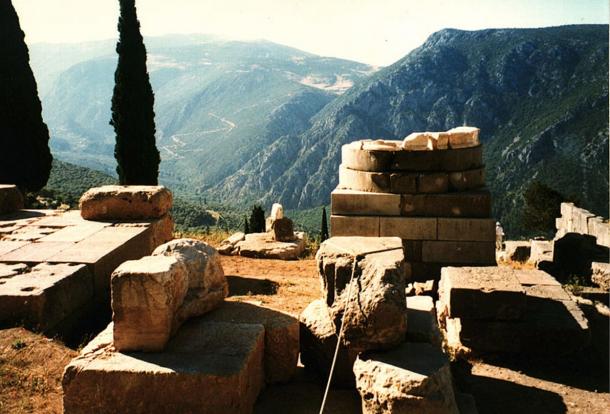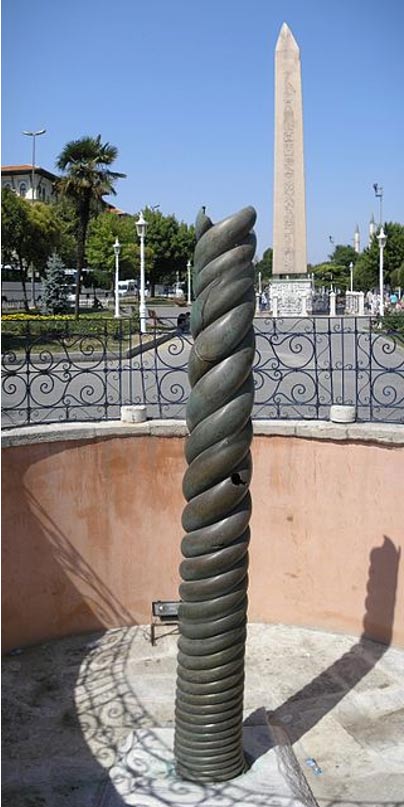
Ancient Three-Headed Serpent Column of Delphi to Rise Again after 2500 Years
An ancient, three-headed snake will return to Delphi, where it originated nearly 2,500 years ago. The Serpent Column is a bronze pillar built in the ancient city of Delphi, Greece, to commemorate those who had fought against the Persian Empire in the Battle of Plataea in 470 B.C. The column was later removed and taken to Constantinople, and now the column is planned to be rebuilt and put on display back at the original site.
Archaeology News Network reports that The Central Archaeological Council has recently announced the copy will be made using a plaster cast. The cast was taken in 1980 and has been safeguarded at the Delphi Museum since that time.

A digital reconstruction of the serpent column. Only the stone base remains at Delphi, and the reproduction will sit atop it. Credit: Ethnos
The bronze column was once an imposing sight. Dark, spiraling snakes comprised the body of the column, which stood 8 meters (26 feet) high. It was topped with three menacing snake heads with open jaws, which in turn supported a golden tripod and great bowl. This impressive offering to Apollo was tribute in 478 B.C. after the Battle of Plataea involving 31 Greek city-states. The city names were inscribed on the column to commemorate the victory over Persian annexation, but they are no longer visible on the original today due to exposure and weathering.

The empty base of a serpent column at Delphi. Wikimedia Commons
The Serpent column is known to be at least 2,492 years old, confirmed by ancient literary references surviving from Greek and Roman antiquity, including literature by Herodotus, Thucydides, and Plutarch.
- Pythia, The Oracle of Delphi
- The Sacred Omphalos Stone, Navel of the World and Communicator of the Gods
- The Ancient Site of Delphi
Herodotus recorded that the metal used in the column was reclaimed from melted-down Persian weapons and armor, and the spoils of war. The Greek historian wrote in Book 9.81., “When the booty had been gathered together, a tenth of the whole was set apart for the Delphian god, and, from this, was made the golden tripod which stands on the three-headed bronze serpent nearest the altar.”

Ottoman miniature from the Surname-i Vehbi, showing the Column with the three serpent heads, in a celebration at the Hippodrome in 1582. Public Domain
The column suffered damage over the centuries. The bowl and tripod have been long lost, and the heads were broken off. The Phoceans are said to have melted down parts of the column to fund the Third Sacred War, writes Archaeology & Arts.
The Serpent Column was ultimately taken to the Hippodrome of Constantinople (modern Istanbul) by Emperor Constantine in 324 A.D. where it stands today.

The authentic Serpent Column at the Hippodrome in Constantinople (Istanbul). Public Domain
Archaeology & Arts notes, “In Constantinople, the Serpent Column was placed in the Hippodrome to decorate the spina (central line). There it stands to this day, a silent witness of the outstanding symbolic value it had for the new capital of the Roman Empire. The fact that it is the only bronze votive which has survived from the Greek Antiquity makes it even more important.”
One remaining snake head is on display at the Istanbul Archaeological Museum.

A part of one of the heads is today in the Istanbul Archaeology Museum. Wikimedia Commons
The return of a Serpent Column to Delphi is expected to attract visitors to the ancient site, recreating the dramatic splendor and rich history of the area.
Featured Image: Close-up of the remaining head of the Serpent Column of Delphi. Schezar/Flickr
By Liz Leafloor














